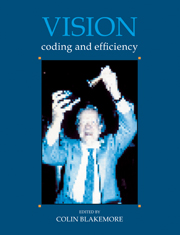Book contents
- Frontmatter
- Contents
- List of Contributors
- Preface
- Reply
- Acknowledgements
- Concepts of coding and efficiency
- Efficiency of the visual pathway
- Colour
- Brightness, adaptation and contrast
- 15 The role of photoreceptors in light-adaptation and dark-adaptation of the visual system
- 16 Why do we see better in bright light?
- 17 Mechanisms for coding luminance patterns: are they really linear?
- 18 Feature detection in biological and artificial visual systems
- Development of vision
- Depth and texture
- Motion
- From image to object
- Index
15 - The role of photoreceptors in light-adaptation and dark-adaptation of the visual system
Published online by Cambridge University Press: 05 May 2010
- Frontmatter
- Contents
- List of Contributors
- Preface
- Reply
- Acknowledgements
- Concepts of coding and efficiency
- Efficiency of the visual pathway
- Colour
- Brightness, adaptation and contrast
- 15 The role of photoreceptors in light-adaptation and dark-adaptation of the visual system
- 16 Why do we see better in bright light?
- 17 Mechanisms for coding luminance patterns: are they really linear?
- 18 Feature detection in biological and artificial visual systems
- Development of vision
- Depth and texture
- Motion
- From image to object
- Index
Summary
Introduction
The aim of this chapter is to review the contribution of the rod and cone photoreceptors to the adaptational behaviour of the overall visual system. Before doing so it is helpful first to distinguish two rather different phenomena which are both referred to as adaptation, and which may be confused.
Light-adaptation (synonymous with background adaptation or field adaptation) refers to the ability of the visual system quickly to establish a new steady state of visual performance when the incident level of illumination changes. Such intensity changes may either be increases or decreases in illumination; in both cases a new operating point is reached within several hundred milliseconds, provided the intensity change is restricted to a few log units (e.g. Crawford, 1947).
Dark-adaptation (synonymous with bleaching adaptation) refers not simply to the behaviour observed after a reduction in light level, but is instead reserved for the special case of recovery following the cessation of extremely intense illumination, which has ‘bleached’ a substantial fraction (say more than 0.1%) of the photopigment in the receptors. This recovery may be extremely slow. For example, following exposure to a very intense light bleaching 90% of the rhodopsin, one's visual sensitivity is initially enormously depressed and only recovers to its final darkadapted level after some 40 minutes.
Shapley & Enroth-Cugell (1984) have set out very clearly the importance of light-adaptation for the visual system. A major purpose of light-adaptation is to provide effective vision over the enormously wide range of intensity which is experienced by the eye.
- Type
- Chapter
- Information
- VisionCoding and Efficiency, pp. 161 - 168Publisher: Cambridge University PressPrint publication year: 1991



